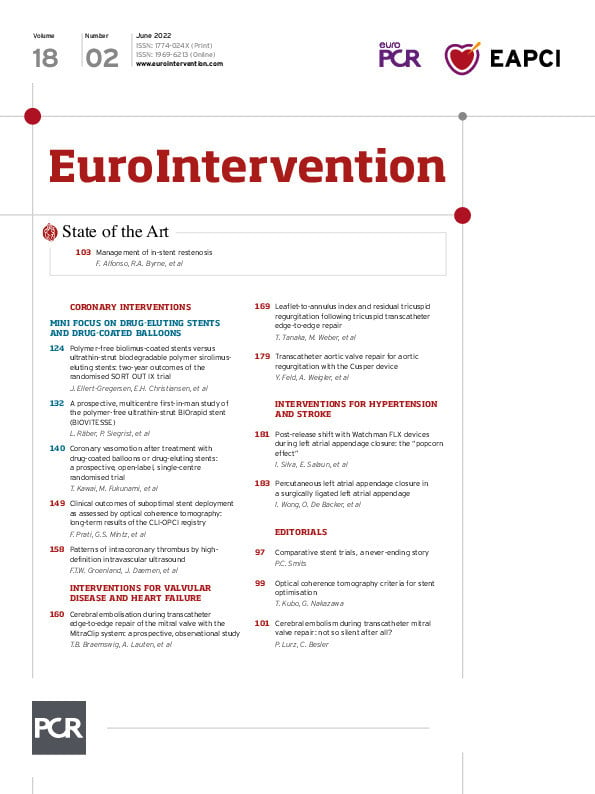The risk of liberating embolic debris is inherent to most, if not all, structural heart interventions. Large-bore device placement within the heart chambers, particularly via a transseptal or transaortic approach, and substantial interaction with cardiac structures may release acute or chronic thrombus, cardiac tissue, and device-related material into the bloodstream. One major consequence, cerebral embolism, is one of the most dreadful periprocedural complications of left-sided structural heart interventions. Ongoing research on cerebral embolic protection devices aims to further improve outcome in patients undergoing transcatheter aortic valve replacement (TAVR)1.
Cerebral embolism in mitral valve interventions has received considerably less attention, likely because the risk of a clinically relevant procedure-related stroke is higher during transcatheter treatment of calcific aortic stenosis as compared to functional or degenerative mitral valve disease. Yet, accumulating evidence from small-scale studies suggests that embolic debris can be captured in cerebral protection devices in all patients undergoing mitral valve transcatheter edge-to-edge repair (M-TEER)2, and in up to 85% of these patients, new ischaemic cerebral lesions are apparent on diffusion-weighted magnetic resonance imaging (MRI)34.
The manuscript by Braemswig and colleagues5, published in the current issue of EuroIntervention, adds to our knowledge on cerebral embolism during M-TEER in two important ways. First, it provides a transcranial Doppler analysis of cerebral microembolic signals in 54 patients during M-TEER with MitraClip (Abbott) and defines the device interaction with the mitral valve as a critical step during which most of cerebral microembolic signals occur. Second, the paper includes a National Institutes of Health Stroke Scale (NIHSS) assessment of patients by a neurologist, before and three days after M-TEER (a timepoint at which transient episodes of neurologic dysfunction as a result of M-TEER should have recovered completely), suggesting that 9/54 patients (17%) demonstrate mild neurological deterioration following the procedure. Notably, the territories of new ischaemic cerebral lesions on MRIs correlated with new neurological deficits on clinical examination.
An important question remains as to what clinical and scientific implications can be derived from the available data on cerebral embolism during M-TEER. Certainly, patients, their family members and physicians should be aware that neurological sequelae may be evident on detailed assessment after M-TEER. Despite being mild, neurological impairments observed by Braemswig et al5 meet the diagnostic criteria for periprocedural stroke put forward by the Neurologic Academic Research Consortium6. At first glance, a periprocedural stroke rate of 17% seems exceptionally high when compared to published clinical trials or registries for M-TEER. However, such a direct comparison is not feasible for several important reasons, including the limited number of patients included in the manuscript by Braemswig et al5, as well as the lack of a uniform definition and assessment of stroke in former M-TEER analyses, which precludes any reliable assumption on the neurological risk attributable to the intervention. For example, clinical follow-up in the present study is limited to 3-4 days and no data on stroke recovery on extended follow-up are provided, whereas other trials or registries report a cumulative stroke rate 30 days after M-TEER, irrespective of their actual relationship to the procedure6. Therefore, a standardised assessment of neurological endpoints in future trials for left-sided structural interventions beyond the TAVR setting is warranted, because even mild neurological deficits (i.e., NIHSS 0-5) are clinically significant and associated with poor outcome, at least in a subset of patients6. Neurological evaluation needs to include neurocognitive function testing; the vast majority of cerebral lesions are apparently located in “non-eloquent” brain areas, but their cumulative burden has been linked to neuropsychological deficits and worsening vascular dementia on longer follow-up.
The particular interaction between the device and the mitral valve during M-TEER seldom becomes apparent during straightforward and immediately successful procedures, but rather during cases where intraprocedural challenges and complications occur, such as entanglement in subvalvular structures, leaflet tears or perforations. The fact that 70% of cerebral microembolic signals in M-TEER occur during valve crossing and grasping is, therefore, reasonable from an interventional perspective. The same holds true for procedure time and leaflet prolapse being predictors of microembolic signals. Repeated alignment and grasping may favour release of embolic material, and leaflets in degenerative mitral regurgitation, particularly Barlow's disease, are characterised by diffuse, excessive valve tissue. Yet, whether valve tissue or thrombus are predominantly released during valve interaction remains to be proven. Based on these observations, a multitude of questions arise regarding cerebral embolism during M-TEER, including but not limited to whether there is a hostile mitral valve anatomy. Does the risk differ depending on which M-TEER device is used? What about other mitral valve interventions such as transcatheter mitral valve implantation?
One thing is clear: cerebrovascular events should not be neglected as we move into lower-risk populations in certain structural heart interventions. The next important steps will be to better define the true incidence of cerebral embolism after M-TEER, its long-term consequences, and to identify subgroups of patients at particular risk. Answering these questions will ultimately decipher the role of cerebral embolic protection in M-TEER. However, as of now, there is not enough evidence to change our default protocol.
Conflict of interest statement
P. Lurz has received institutional fees and grants from Edwards Lifesciences, ReCor Medical and Abbott. C. Besler has received institutional fees from Edwards Lifesciences and Abbott.
Supplementary data
To read the full content of this article, please download the PDF.

